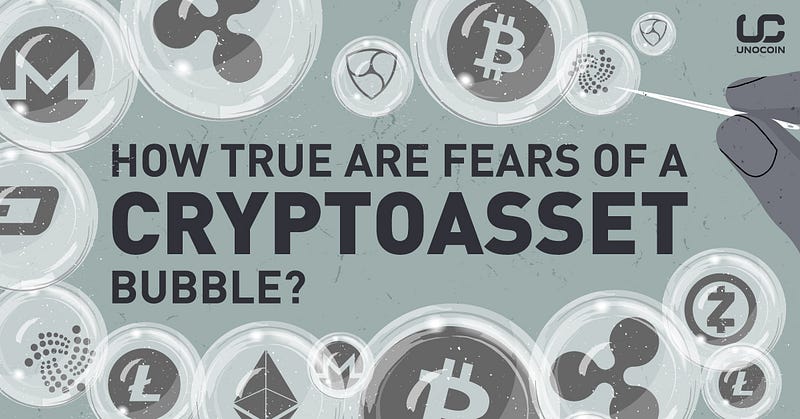
Any conversation around crypto coins focuses predominantly on two themes: the financial and technical aspects. The underlying ledger technology and encryption algorithms have fascinated academia, industry experts and even people at the grass root level across. Simultaneously, the financial aspects of cryptoassets have intrigued pundits and economists across the globe. Many enthusiasts would jump at the opportunity to champion the concept and the entity of a cryptoasset.
However, there are others who would either steer away from investing time and money in the crypto market or voice concerns about an impending doom that they believe might envelope the cryptoassets. Although the fears stem from some valid reasons, not all their fears can be justified in reason. The rocketing prices for bitcoin have helped the market capitalisation of cryptoassets touch $500bn. This naturally makes many wonder if we’re in the midst of a bubble.
Fears lurking around the concept
Industry experts have succinctly categorized the fear around cryptoassets in two classes: financial and technical. While the financial skepticism generally talks about it being a bubble, the technical side is that coins will be lost, stolen/hacked, or just be subjected to fraud. Creative theft, hacking and other technological caveats form the bulk of concerns around this space for most people. The underlying Blockchain technology is also being scrutinized by many others in this space.
However, more than the people who express some doubts about the same, there are others who are more than happy to welcome the technology in various other applications. John Monarch, CEO of ShipChain, a blockchain based logistics software company, said, “It’s a new asset class that has taken the world by a storm since Bitcoin first hit the scene. The volatility in the market might add fuel to the fear, but the excitement around the base technology seems to be outpacing that. I’d say most people actually involved are more happy about the evolution of cryptoassets and blockchain than they are fearful.”

It can be compromised using selected, targeted Cyber Intrusion practices leading to a hack with malware or ransomware. Additionally, it is believed that unregistered wallets and transactions are safer from a hack than registered ones.
Many cryptoassets have not been audited by their regulators and in 2018 they might be stated in examples of financial audits and failed stories. Many investors suspect their coin miners or exchanges might be shut down due to non-compliance of regulations and rules. A part of the fear also comes in when governments across countries have publicly banned digital assets thus, having zero recourse or refund.
Bitcoin is not underpinned by a central bank. It allows users to bypass traditional payment systems when transacting — a premise that has naturally caught the imagination of many, leading to a price surge of more than 900% in 2017. Created by ‘miners,’ Bitcoin often has to deal with fears of an economic bubble.
The rising skepticism hovers around investors as Bitcoin becomes treated less like a asset and more like a store of value, open for speculators making huge bets on how far the value can rise. Economists have also compared bitcoin’s meteoric rise with past bubbles like the tulip mania of the 17th century. The dotcom bubble that started in the late 90s with the Nasdaq index in New York and burst in 2000 also foreshadows a devastating collapse for coinage that has no intrinsic value to the investors beyond what was ascribed to it by a community of creators.
Are the fears justified?

Despite having ‘bubble-like’ qualities in the cryptoasset space, experts brush aside the thought of the concept tumbling down. They see credit in the fact that the price of cryptoassets could be affected only if something unfortunate were to happen to the protocol that underlies it. Experts explain that the cryptoasset price fluctuations are not the same thing as an artificially hiked price or “bubble.” It is the result of a technological or community failure, but not on the chance of market failure.
When Bitcoin upgraded to Segwit it did not necessarily align with Satoshi Nakamoto’s vision that Bitcoin should be a scalable, peer-2-peer cash system. On the other hand, it converted bitcoin into a settlement layer, which might cause some charm to the asset. In either case, people hope that Segwit will work well for Bitcoin in the long run. The hope is that they would not see a technological failure that takes the cryptoasset down.
This just goes on to establish that cryptoassets are susceptible to failures and crashes. It is just that these potential crashes are not the result of a “bubble.” They would occur because the community failed to make the crypto coin economically viable. When it comes to the technology, Blockchain has invaded all niche tech-spaces — from IoT to Big Data analytics. Every industry is talking about incorporating Blockchain in their operations and functioning owing to the benefits it offers in terms of a decentralized and secure system of interconnected systems. With promises of that kind, Blockchain technology is bound to stay and develop over time.
Also Read:
https://blog.unocoin.com/investing-in-bitcoin-futures-a-step-by-step-guide-4a65853f7e59



